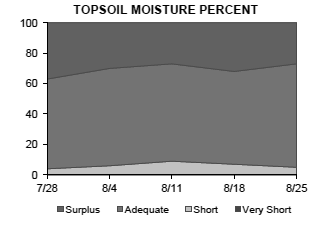North Carolina has received above average amounts of rain this summer and, according to reports from the N.C. Department of Agriculture, the impact is substantial. The downpour has destroyed crops, decreased insect populations and even devastated some towns.
According to Brian Long, public affairs director for the N.C. Department of Agriculture, this year’s rain has been so drastic that Ashville had nearly 58 inches of rain – almost 26 inches more than normal for the entire year. The city is now the second wettest place in the country, behind Mt. Waialeale, Hawaii, which receives approximately 387 inches of rainfall annually.
“What we’ve seen, particularly in the western part of the state, is far more rain than was actually needed, from an agricultural standpoint,” Long said. “There are stories of farmers in the mountainous regions whose crops were completely under water because they were located along valleys and riverbeds.”
Stewart Akers, a cattle farmer in Alexander County, has experienced the effects of the rain firsthand.
“It’s been great for watering my pastures, but in terms of getting work done, it’s been terrible,” Akers said. “There hasn’t been enough time to let hay dry to get it cut.”
Dairy farms across the state have lost the corn crop they use to feed their cows, while vegetable farms have started to see an impact on yields for various crops.
“Last year, we had record yields for several crops — cotton, peanuts and soy beans,” Long said. “Matching those numbers again this year was already unlikely. What we’re seeing is that the projected yield estimates for cotton, peanuts and soy beans are all looking to be way down compared to last year.”
Long said cotton yield is expected to be 775 pounds per acre — 239 pounds per acre less than what was reported last year — and attributes the decrease to the weather. There has also been an impact on winter wheat, which was harvested earlier in the summer. The harvest was delayed because of the wet weather, since farmers are unable to work when the fields are too wet. The yield of wheat was only down a bushel per acre.
Not only has the actual yield of many crops decreased, but the overall quality has decreased as well.
“If the crop sits in the field for too long, the heads can sprout, and if that happens, the quality is not nearly as high as farmers would like.” Long said. “The quality also determines how much it can be sold for.”
“Tobacco farmers are still in a wait-and-see period,” Long said. “Tobacco is a crop that doesn’t need a lot of water, but if it has time to recover, it can still turn out OK. The latest forecasts for the tobacco crop predict a decrease in yield from last year.”
While drought has been a problem for North Carolina’s farmers in previous years, local crops can suffer more greatly during periods of extreme rain.
“There are ways for farmers to irrigate their crops during a drought, but they are unable to remove too much water,” Long said.
As for the state’s active hurricane season, which traditionally starts in late August, Long said any tropical storm would be doubly disastrous.
“We’ve already had a really wet summer, and we haven’t even yet started the busy season for tropical storms in N.C.,” Long said. “Several major hurricanes that struck N.C. all struck in September, and include hurricanes Floyd, Isabel, Fran and Irene. We could really stand to not be visited by a tropical storm or hurricane this year.”
While the summer rain has had some serious immediate effects, Long said there is not much worry for the coming seasons. According to the most recent soil studies, the statewide topsoil moisture has begun to dry out a little bit in the last week.
“That means that they’ve got plenty of soil moisture and some to spare, so adding a hurricane on top of that would most likely indicate a flooding situation that can be very damaging to homes and businesses as well as crops,” Long said. “91 percent of the soil in the coastal region is rated at adequate or surplus, which is a good sign for the future.”








